
The Ford Laser is a compact car, originally a subcompact car in the first three generations, which was sold by Ford in Asia, Oceania, and parts of South America and Africa. It has generally been available as a sedan or hatchback, although convertible, wagon and pick-up versions have also been available in different markets. The sedan, and briefly station wagon, versions were badged Ford Meteor in Australia between 1981 and 1987. The Ford Meteor name was also used in South Africa.

The Ford Telstar is an automobile that was sold by Ford in Asia, Australasia and Africa, comparable in size to the European Ford Sierra and the North American Ford Tempo. It was progressively replaced by the Ford Mondeo. The car was named after the Telstar satellite.

The Ford Festiva is a subcompact car that was designed and manufactured by Mazda for Ford between 1986 and 2002. Festiva was sold in Japan, the Americas, and Australia. The name "Festiva" is derived from the Spanish word for "festive". It was not related to the similarly sized and named Ford Fiesta, and was not replaced by the Ford Ka, which is smaller.

The Ford Probe is a liftback coupé produced by Ford, introduced in 1988 and produced until 1997. The Probe was the result of Ford's collaboration with its longtime Japanese partner Mazda, and both generations of Probe were derived from the front-wheel drive Mazda G platform that underpinned the Mazda Capella.
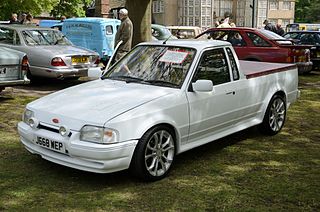
The Ford Bantam is a coupé utility/pickup produced in South Africa. Production of the Bantam spanned three generations, with the vehicle produced in South Africa for sale within the South African market.

The Mazda MPV is a minivan manufactured by Mazda. Introduced in 1988 as a rear-wheel-drive model with optional selectable four-wheel drive, this was replaced in 1999 with a front-wheel-drive version with optional all-wheel-drive in some markets. Over one million MPV models have been produced since its introduction.

The Mazda Capella, also known as the 626 in Europe, North America and Southeast Asia, is a mid-size car that was manufactured by Mazda from 1970 until 2002. Sold in the Japanese domestic market under the Capella name, the vehicle was also commonly known in other major markets as the Mazda 626. Ford, Mazda's partner at the time, also used the Capella platform to create the Ford Telstar and Ford Probe. 4,345,279 of the 626 and Telstar models were sold worldwide.

The Mazda MX-6 is a front-engine, front-wheel-drive coupé manufactured and marketed by Mazda from 1987 to 1997 across two generations.
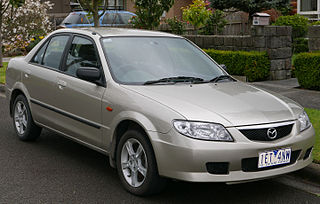
The Mazda Familia, also marketed prominently as the Mazda 323, Mazda Protegé and Mazda Allegro, is a small family car that was manufactured by Mazda between 1963 and 2003. The Familia line was replaced by the Mazda3/Axela for 2004.

The Mazda Bongo, also known as Mazda E-Series, and the Ford Econovan, is a cabover van and pickup truck manufactured by the Japanese automobile manufacturer Mazda since 1966. The Bongo name was also used for the Bongo Friendee, which is not a cabover design.

The Mazda Tribute is a compact SUV made by Japanese automaker Mazda from 2000 to 2011. It was jointly developed with Ford Motor Company and based on the front-wheel drive Mazda 626 platform, which was in turn the basis for the similar Ford Escape on the CD2 platform. The Tribute was priced below the Ford Escape and Mercury Mariner in Ford's CD2 SUV lineup.
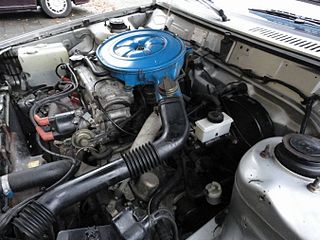
The F engine family from Mazda is a mid-sized inline-four piston engine with iron block, alloy head and belt-driven SOHC and DOHC configurations. Introduced in 1983 as the 1.6-litre F6, this engine was found in the Mazda B-Series truck and Mazda G platform models such as Mazda 626/Capella as well as many other models internationally including Mazda Bongo and Ford Freda clone, Mazda B-series based Ford Courier, Mazda 929 HC and the GD platform-based Ford Probe
The Mazda B-series is a small-sized, iron-block, inline four-cylinder engine with belt-driven SOHC and DOHC valvetrain ranging in displacement from 1.1 to 1.8 litres. It was used in a wide variety of applications, from front-wheel drive economy vehicles to the turbocharged full-time 4WD 323 GTX and rear-wheel drive Miata.

The iron-block, alloy head E family was an evolution of Mazda's xC design. It was released in June 1980 with the introduction of the first front-wheel drive Mazda Familias and Ford Lasers. Some later variants of the E5-powered Mazda Familia and Ford Laser in Japan incorporated a full-time 4WD drivetrain. All E engines were chain-driven, 8-valve SOHC. Notable features include siamesed cylinders, aluminium rocker arms and pistons, thin block walls, and single valve springs - all in the interest of reducing weight.

The Ford Ranger is a range of pickup trucks manufactured and marketed by Ford Motor Company in North and South America under the Ford Ranger nameplate. Introduced in early 1982 for the 1983 model year, the Ranger is currently in its fourth generation. Developed as a replacement for the Mazda-sourced Ford Courier, the model line has been sold across the Americas; Ford of Argentina began production of the Ranger for South America in 1998.

The Mazda Titan is a commercial truck produced by the Japanese automaker Mazda since 1971. From the fourth generation onwards, the vehicle had become a rebadged Isuzu Elf truck.

The Nissan Vanette is a cabover van and pickup truck produced by the Japanese automaker Nissan from 1978 until 2011. The first two generations were engineered by Nissan's Aichi Manufacturing Division for private, personal ownership, with the last two generations built by Mazda, rebadged as Nissans and refocused as commercial vehicles, based on the Mazda Bongo. The van has also been sold as the Nissan Sunny-Vanette or Nissan Van. The private purchase passenger platform was replaced by the Nissan Serena in 1991, renamed Vanette in various international markets, and came equipped with multiple engine and drivetrain configurations.
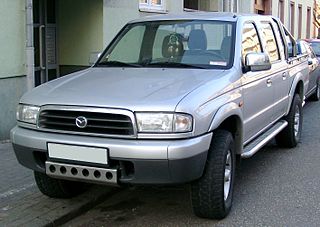
The Mazda B series is a series of pickup trucks that was manufactured by Mazda. Produced across five generations from 1961 to 2006, the model line began life primarily as a commercial vehicle, slotted above a kei truck in size. Through its production, Mazda used engine displacement to determine model designations; a B1500 was fitted with a 1.5 L engine and a B2600, a 2.6 L engine.
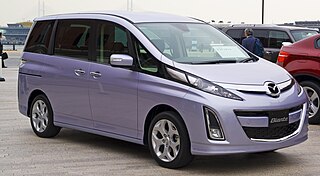
The Mazda Biante is an 8-seater minivan introduced for the Japanese market in 2008 by Mazda, replacing the Bongo Friendee. The car fits between the Premacy and MPV in Mazda's range. The Biante is primarily aimed at younger families with small children.

The Mazda Premacy is a passenger minivan that was built by the Japanese manufacturer Mazda from 1999 to 2018.



















